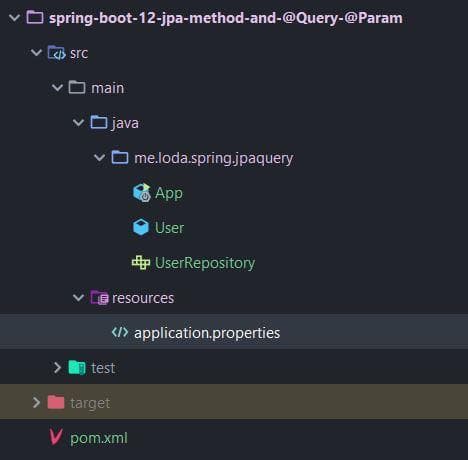5s quảng cáo
 Mình có 1 shopee nho nhỏ bán ốp iPhone kunn.oops, mọi người ủng hộ nhé :D
Mình có 1 shopee nho nhỏ bán ốp iPhone kunn.oops, mọi người ủng hộ nhé :D
Giới thiệu
Trong bài trước, mình đã giới thiệu với các bạn Spring JPA, với cách cài đặt và sử dụng hết sức dễ dàng.
Nhưng trong thực tế, sẽ có một số yêu cầu nghiệp vụ nằm ngoài các method là JPA hỗ trợ sẵn, lúc này bạn phải tự tạo ra câu query của riêng mình.
Trong phần này, chúng ta sẽ tìm hiểu cách để tự tạo ra các câu truy vấn.
Query Creation
Trong Spring JPA, có một cơ chế giúp chúng ta tạo ra các câu Query mà không cần viết thêm code.
Cơ chế này xây dựng Query từ tên của method.
Ví dụ:
Chúng ta có đối tượng User.
User.java
@Entity @Table(name = "user") @Data public class User implements Serializable { private static final long serialVersionUID = -297553281792804396L; @Id @GeneratedValue(strategy = GenerationType.IDENTITY) private Long id; // Mapping thông tin biến với tên cột trong Database @Column(name = "hp") private int hp; @Column(name = "stamina") private int stamina; // Nếu không đánh dấu @Column thì sẽ mapping tự động theo tên biến private int atk; private int def; private int agi; }
Khi chúng ta đặt tên method là: findByAtk(int atk)
Thì Spring JPA sẽ tự định nghĩa câu Query cho method này, bằng cách xử lý tên method. Vậy là chúng ta đã có thể truy vấn dữ liệu mà chỉ mất thêm 1 dòng code.
Cơ chế xây dựng Query từ tên method này giúp chúng ta tiết kiệm thời gian với những query có logic đơn giản, và cũng đặc biệt hữu ích là nó giống ngôn ngữ con người thường nói hơn là SQL. (human-readable)
Quy tắc đặt tên method trong Spring JPA
Trong Spring JPA, cơ chế xây dựng truy vấn thông qua tên của method được quy định bởi các tiền tố sau:
find…By, read…By, query…By, count…By, và get…By.
phần còn lại sẽ được parse theo tên của thuộc tính (viết hoa chữ cái đầu). Nếu chúng ta có nhiều điều kiện, thì các thuộc tính có thể kết hợp với nhau bằng chữ And hoặc Or.
Ví dụ:
interface PersonRepository extends JpaRepository<User, Long> { // Dễ // version rút gọn Person findByLastname(String lastname); // verson đầy đủ Person findPersonByLastname(String lastname); Person findAllByLastname(String lastname); // Trung bình List<Person> findByEmailAddressAndLastname(EmailAddress emailAddress, String lastname); // findDistinct là tìm kiếm và loại bỏ đi các đối tượng trùng nhau List<Person> findDistinctPeopleByLastnameOrFirstname(String lastname, String firstname); List<Person> findPeopleDistinctByLastnameOrFirstname(String lastname, String firstname); // IgnoreCase là tìm kiếm không phân biệt hoa thường, ví dụ ở đây tìm kiếm lastname // lastname sẽ không phân biệt hoa thường List<Person> findByLastnameIgnoreCase(String lastname); // AllIgnoreCase là không phân biệt hoa thường cho tất cả thuộc tính List<Person> findByLastnameAndFirstnameAllIgnoreCase(String lastname, String firstname); // OrderBy là cách sắp xếp thứ tự trả về // Sắp xếp theo Firstname ASC List<Person> findByLastnameOrderByFirstnameAsc(String lastname); // Sắp xếp theo Firstname Desc List<Person> findByLastnameOrderByFirstnameDesc(String lastname); }
Các thuộc tính trong tên method phải thuộc về Class đó, nếu không sẽ gây ra lỗi. Tuy nhiên, trong một số trường hợp bạn có thể query bằng thuộc tính con.
Ví dụ:
Đói tượng Person có thuộc tính là Address và trong Address lại có ZipCode
// person.address.zipCode List<Person> findByAddressZipCode(ZipCode zipCode);
@Query
nếu bạn thực sự thấy khó với cách tiếp cận ở phía trên, thì Spring JPA còn hỗ trợ chúng ta một cách nguyên thủy khác.
Với cách sử dụng @Query, bạn sẽ có thể sử dụng câu truy vấn JPQL (Hibernate) hoặc raw SQL.
Nếu bạn chưa biết JPQL thì có thể xem tại đây
Ví dụ:
public interface UserRepository extends JpaRepository<User, Long> { // Khi được gắn @Query, thì tên của method không còn tác dụng nữa // Đây là JPQL @Query("select u from User u where u.emailAddress = ?1") User myCustomQuery(String emailAddress); // Đây là Native SQL @Query(value = "select * from User u where u.email_address = ?1", nativeQuery = true) User myCustomQuery2(String emailAddress); }
Cách truyền tham số là gọi theo thứ tự các tham số của method bên dưới ?1, ?2
Nếu bạn không thích sử dụng ?{number} thì có thể đặt tên cho tham số.
public interface UserRepository extends JpaRepository<User, Long> { // JPQL @Query("SELECT u FROM User u WHERE u.status = :status and u.name = :name") User findUserByNamedParams(@Param("status") Integer status, @Param("name") String name); // Native SQL @Query(value = "SELECT * FROM Users u WHERE u.status = :status and u.name = :name", nativeQuery = true) User findUserByNamedParamsNative(@Param("status") Integer status, @Param("name") String name); }
Demo
Chúng ta sẽ thử hết các cách ở trên bằng demo dưới đây:
pom.xml
<?xml version="1.0" encoding="UTF-8"?>
<project xmlns="http://maven.apache.org/POM/4.0.0" xmlns:xsi="http://www.w3.org/2001/XMLSchema-instance"
xsi:schemaLocation="http://maven.apache.org/POM/4.0.0 http://maven.apache.org/xsd/maven-4.0.0.xsd">
<modelVersion>4.0.0</modelVersion>
<packaging>pom</packaging>
<parent>
<groupId>org.springframework.boot</groupId>
<artifactId>spring-boot-starter-parent</artifactId>
<version>2.0.5.RELEASE</version>
<relativePath /> <!-- lookup parent from repository -->
</parent>
<groupId>me.loda.spring</groupId>
<artifactId>spring-boot-learning</artifactId>
<version>0.0.1-SNAPSHOT</version>
<name>spring-boot-learning</name>
<description>Everything about Spring Boot</description>
<properties>
<java.version>1.8</java.version>
</properties>
<dependencies>
<!--spring mvc, rest-->
<dependency>
<groupId>org.springframework.boot</groupId>
<artifactId>spring-boot-starter-web</artifactId>
</dependency>
<!--spring jpa-->
<dependency>
<groupId>org.springframework.boot</groupId>
<artifactId>spring-boot-starter-data-jpa</artifactId>
</dependency>
<!-- mysql connector -->
<dependency>
<groupId>mysql</groupId>
<artifactId>mysql-connector-java</artifactId>
</dependency>
</dependencies>
<build>
<plugins>
<plugin>
<groupId>org.springframework.boot</groupId>
<artifactId>spring-boot-maven-plugin</artifactId>
</plugin>
</plugins>
</build>
</project>
Cấu trúc thư mục:

Tạo Database
CREATE DATABASE micro_db; use micro_db; CREATE TABLE `user` ( `id` bigint(20) NOT NULL AUTO_INCREMENT, `hp` int NULL DEFAULT NULL, `stamina` int DEFAULT NULL, `atk` int DEFAULT NULL, `def` int DEFAULT NULL, `agi` int DEFAULT NULL, PRIMARY KEY (`id`) ); DELIMITER $$ CREATE PROCEDURE generate_data() BEGIN DECLARE i INT DEFAULT 0; WHILE i < 100 DO INSERT INTO `user` (`hp`,`stamina`,`atk`,`def`,`agi`) VALUES (i,i,i,i,i); SET i = i + 1; END WHILE; END$$ DELIMITER ; CALL generate_data();
Cấu hình Spring
application.properties
server.port=8081 spring.datasource.url=jdbc:mysql://localhost:3306/micro_db?useSSL=false spring.datasource.username=root spring.datasource.password=root ## Hibernate Properties # The SQL dialect makes Hibernate generate better SQL for the chosen database spring.jpa.properties.hibernate.dialect = org.hibernate.dialect.MySQL5InnoDBDialect # Hibernate ddl auto (create, create-drop, validate, update) spring.jpa.hibernate.ddl-auto = update logging.level.org.hibernate = ERROR
Tạo Model và Repository
User.java
@Entity @Table(name = "user") @Data public class User implements Serializable { private static final long serialVersionUID = -297553281792804396L; @Id @GeneratedValue(strategy = GenerationType.IDENTITY) private Long id; // Mapping thông tin biến với tên cột trong Database @Column(name = "hp") private int hp; @Column(name = "stamina") private int stamina; // Nếu không đánh dấu @Column thì sẽ mapping tự động theo tên biến private int atk; private int def; private int agi; }
UserRepository.java
import org.springframework.data.jpa.repository.JpaRepository; import org.springframework.data.jpa.repository.Query; import org.springframework.data.repository.query.Param; import org.springframework.stereotype.Repository; @Repository public interface UserRepository extends JpaRepository<User, Long> { List<User> findAllByAtk(int atk); List<User> findAllByAgiBetween(int start, int end); @Query("SELECT u FROM User u WHERE u.def = :def") User findUserByDefQuery(@Param("def") Integer def); List<User> findAllByAgiGreaterThan(int agiThreshold); }
Chạy thử chương trình
App.java
import org.springframework.boot.SpringApplication; import org.springframework.boot.autoconfigure.SpringBootApplication; import org.springframework.context.ApplicationContext; import lombok.RequiredArgsConstructor; @SpringBootApplication @RequiredArgsConstructor public class App { public static void main(String[] args) { ApplicationContext context = SpringApplication.run(App.class, args); UserRepository userRepository = context.getBean(UserRepository.class); System.out.println("Tìm user với Agi trong khoảng (25 - 30)"); System.out.println("findAllByAgiBetween: "); userRepository.findAllByAgiBetween(25, 30) .forEach(System.out::println); System.out.println("==========================================="); System.out.println("Tìm user với Agi trong lớn hơn 97"); System.out.println("findAllByAgiGreaterThan: "); userRepository.findAllByAgiGreaterThan(97) .forEach(System.out::println); // Tìm kiếm tất cả theo Atk = 74 System.out.println("==========================================="); System.out.println("Tìm user với Atk = 74"); System.out.println("findAllByAtk: "); userRepository.findAllByAtk(74) .forEach(System.out::println); System.out.println("==========================================="); System.out.println("Tìm User với def = 49"); System.out.println("SELECT u FROM User u WHERE u.def = :def"); User user = userRepository.findUserByDefQuery(49); System.out.println("User: " + user); } }
OUTPUT chương trình:
Tìm user với Agi trong khoảng (25 - 30) findAllByAgiBetween: User(id=26, hp=25, stamina=25, atk=25, def=25, agi=25) User(id=27, hp=26, stamina=26, atk=26, def=26, agi=26) User(id=28, hp=27, stamina=27, atk=27, def=27, agi=27) User(id=29, hp=28, stamina=28, atk=28, def=28, agi=28) User(id=30, hp=29, stamina=29, atk=29, def=29, agi=29) User(id=31, hp=30, stamina=30, atk=30, def=30, agi=30) =========================================== Tìm user với Agi trong lớn hơn 97 findAllByAgiGreaterThan: User(id=99, hp=98, stamina=98, atk=98, def=98, agi=98) User(id=100, hp=99, stamina=99, atk=99, def=99, agi=99) =========================================== Tìm user với Atk = 74 findAllByAtk: User(id=75, hp=74, stamina=74, atk=74, def=74, agi=74) =========================================== Tìm User với def = 49 SELECT u FROM User u WHERE u.def = :def User: User(id=50, hp=49, stamina=49, atk=49, def=49, agi=49)
Kết quả hoàn hảo tới mức Perfect :) Chúc bạn thành công
Kết
Khi tới đây, tôi muốn bạn tham khảo thêm một số khái niệm sau nếu có thời gian:
- Hướng dẫn sử dụng Criteria API trong Hibernate
- 「Jpa」Hướng dẫn sử dụng @OneToOne
- 「Jpa」Hướng dẫn @OneToMany và @ManyToOne
- 「Jpa」Hướng dẫn @ManyToMany
Đây là một bài viết trong Series làm chủ Spring Boot, từ zero to hero
Như mọi khi, toàn bộ code tham khảo tại Github
 DaoThaiSon.me
DaoThaiSon.me
